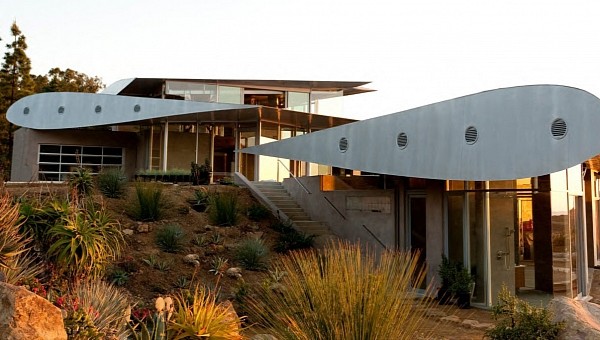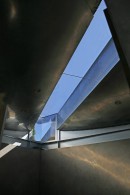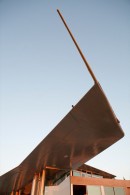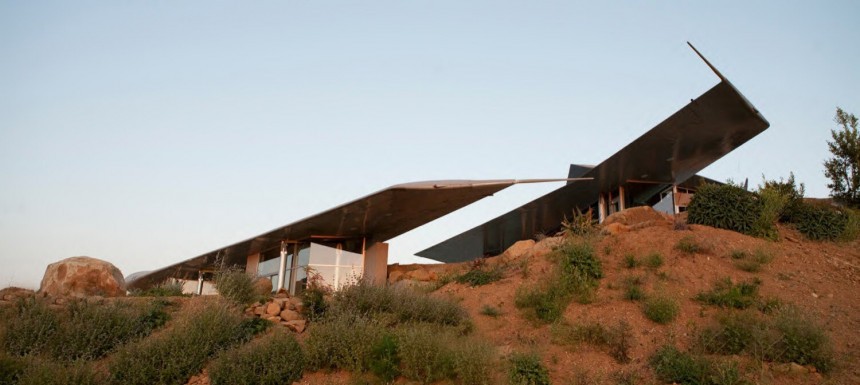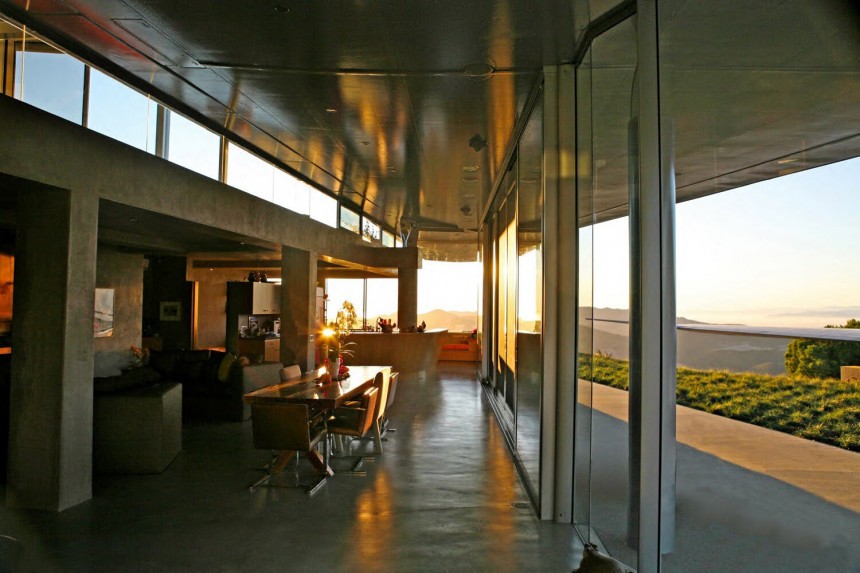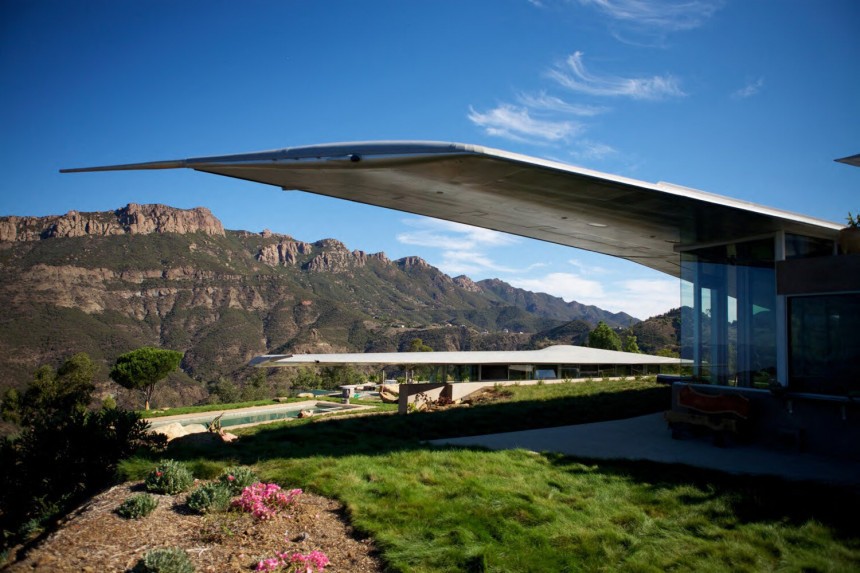Sometimes, the only way in which you can stand out is to flat-out ignore the nay-sayers and just carve your own path. As long as you can afford it, that is.
The 747 Wing House is one woman and one architect’s way of carving their own path: a unique residential structure that uses entire parts of a decommissioned Boeing 747-100 airplane, of which many said it would never be completed or, for that matter, that it made no sense, even if it were. It was a six-year journey from idea to completion, one that placed the focus on sustainability, upcycling, and the pursuit of the dream family home.
It’s a bonkers story, but one with a happy ending, and we’re all for happy endings. As the home ownerherself once said, this unique house is her “antidote to the malling of America,” her way of showing that you can turn junk into sustainable architecture – and that it can be pretty too. The 747 Wing House is also an international star, but that’s only because of how bonkers the whole project became.
Large passenger aircraft is a very viable and oftentimes convenient option for alternative housing. Airplanes offer a large footprint to work with, and they’re lightweight and durable, which means you won’t ever have to worry about moisture, freezing temperatures, or high winds. Once you look past the linear layout and adjust to it, airplanes can become very cozy homes that are very energy-efficient and relatively maintenance-free.
Of course, airplanes also have to be moved from whatever junkyard you buy them from on the cheap, and that’s where things tend to get very complicated. The 747 Wing House was no exception, and it was precisely this journey from the junkyard to the Ventura County portion of the Santa Monica Mountains near Malibu, California that turned it into a star.
The unique house is the brainchild and prized possession of Francie Rehwald, a hippie-like environmentalist who bought the plot of land for it from the estate of Hollywood set designer Tony Duquette, another dedicated environmentalist, builder, and lover of all things DIY. The fire of 1993 had burned most of the constructions on site to the ground, so Rehwald bought the land with the goal of reusing what was still left and, in this way, continuing Duquette's legacy.
Of course, it helps that Rehwald has the “heiress” title to her name: her family founded the first Mercedes-Benz dealership in southern California and, while she never disclosed her line of work, it’s safe to assume she wasn’t exactly counting pennies with this project.
The house was designed by American architect David Randall Hertz, on a brief that called for a sustainable structure that had “curves” and a feminine silhouette. Hertz got the idea of using parts of a plane for it during a flight home (of course), thinking about a curved roofline, and realizing that there are curves to the wings of a plane.
Hertz and Rehwald bought the Boeing 747 for $35,000. Delivered in 1970, it had been one of the original PanAms before it was bought by Tower Air and eventually scrapped. It was gutted on site and lasered apart, with the duo deciding that they would use as many parts from it as they could, starting with the wings and the tail fins. Hertz’s idea, which he was eventually able to bring into reality, was to use the wings as roofs, cantilevered off the ground so that they looked as if they floated.
Each wing is anchored to the ground on one side, and those anchor points support its entire weight, so that it looks as if it’s floating above ground. Since an airplane’s fuselage is made of lightweight aluminum, this allowed Hertz to use self-supporting glass walls instead of the usual load-bearing materials, so the house is very energy-efficient. He used high-performance glass, so it costs less to heat up or cool down the house, or light it during the day, since it’s inundated with natural light. Wing House also has a large solar panel array for electricity and a thermal solar system for heating water.
But building it was the easier part of the project; bringing the parts of the 747 up the hill was the most difficult. A large convoy and closing off interstates were necessary steps in getting the cut-up plane closer to the site, by truck. Then, because of the site’s location, the team had to rent a Chinook helicopter to bring the sawed-up pieces one by one.
Even with the costs of the convoy and the rented helicopter factored in, Hertz said that building the house was still cheaper than it would have been using conventional methods. His unique approach also translated into a lower carbon footprint for the entire project and a lower carbon footprint for the lifetime of the home.
It took Hertz six full years to complete the build, mostly because of red tape. Rehwald was able to finally move into her dream home in 2011: over 4,000 square feet (371.6 square meters) of space divided between eight different structures, including the main residence, a guest house, a meditation pavilion made from the plane’s nose, and even a shelter for animals made from the lower part of the fuselage that once held the cargo area.
To Hertz, the 747 Wing House is a brilliant example of regenerative design, as well as a commentary on the disposable nature of our society. To Rehwald, it’s her dream home, built by upcycling junk and with a very sustainable aspect to it. To the rest of the world, it’s an oddity, but one that tells a very captivating story about determination – and probably an unlimited budget. Beauty may be in the eye of the beholder, but a good backstory isn’t debatable. This house makes for an awesome conversation starter.
It’s a bonkers story, but one with a happy ending, and we’re all for happy endings. As the home ownerherself once said, this unique house is her “antidote to the malling of America,” her way of showing that you can turn junk into sustainable architecture – and that it can be pretty too. The 747 Wing House is also an international star, but that’s only because of how bonkers the whole project became.
Large passenger aircraft is a very viable and oftentimes convenient option for alternative housing. Airplanes offer a large footprint to work with, and they’re lightweight and durable, which means you won’t ever have to worry about moisture, freezing temperatures, or high winds. Once you look past the linear layout and adjust to it, airplanes can become very cozy homes that are very energy-efficient and relatively maintenance-free.
The unique house is the brainchild and prized possession of Francie Rehwald, a hippie-like environmentalist who bought the plot of land for it from the estate of Hollywood set designer Tony Duquette, another dedicated environmentalist, builder, and lover of all things DIY. The fire of 1993 had burned most of the constructions on site to the ground, so Rehwald bought the land with the goal of reusing what was still left and, in this way, continuing Duquette's legacy.
Of course, it helps that Rehwald has the “heiress” title to her name: her family founded the first Mercedes-Benz dealership in southern California and, while she never disclosed her line of work, it’s safe to assume she wasn’t exactly counting pennies with this project.
The house was designed by American architect David Randall Hertz, on a brief that called for a sustainable structure that had “curves” and a feminine silhouette. Hertz got the idea of using parts of a plane for it during a flight home (of course), thinking about a curved roofline, and realizing that there are curves to the wings of a plane.
Each wing is anchored to the ground on one side, and those anchor points support its entire weight, so that it looks as if it’s floating above ground. Since an airplane’s fuselage is made of lightweight aluminum, this allowed Hertz to use self-supporting glass walls instead of the usual load-bearing materials, so the house is very energy-efficient. He used high-performance glass, so it costs less to heat up or cool down the house, or light it during the day, since it’s inundated with natural light. Wing House also has a large solar panel array for electricity and a thermal solar system for heating water.
But building it was the easier part of the project; bringing the parts of the 747 up the hill was the most difficult. A large convoy and closing off interstates were necessary steps in getting the cut-up plane closer to the site, by truck. Then, because of the site’s location, the team had to rent a Chinook helicopter to bring the sawed-up pieces one by one.
Even with the costs of the convoy and the rented helicopter factored in, Hertz said that building the house was still cheaper than it would have been using conventional methods. His unique approach also translated into a lower carbon footprint for the entire project and a lower carbon footprint for the lifetime of the home.
To Hertz, the 747 Wing House is a brilliant example of regenerative design, as well as a commentary on the disposable nature of our society. To Rehwald, it’s her dream home, built by upcycling junk and with a very sustainable aspect to it. To the rest of the world, it’s an oddity, but one that tells a very captivating story about determination – and probably an unlimited budget. Beauty may be in the eye of the beholder, but a good backstory isn’t debatable. This house makes for an awesome conversation starter.
